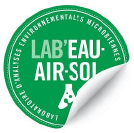Iron ochre deposit
Have you noticed a reddish, gelatinous buildup in a foundation drain ? It could be an iron ochre problem. This poses a serious threat to air quality and thus to the health of occupants, since it can result in basement flooding, excessive humidity and, consequently, the appearance of mould.
Iron ochre is a deposit of iron hydroxide caused by ferruginous bacteria present in groundwater. When conditions are optimal for its formation, iron ochre can grow in volume and clog drains, then proliferate in catch basins and around pumps. Iron ochre is found as a gelatinous, viscous, reddish mass. Ochre can be formed in two ways : chemically or biologically.
The biological process is the fastest and generally leads to larger accumulations. The chemical process, on the other hand, is slower and rarely causes Accumulation problems.
In what situations can Lab’EauAirSol help you with a iron ochre deposits at home?
- Would you like a price estimate for the analysis of iron ochre deposits in your home?
- You suspect an iron ochre problem in your home
- Want to find the best solutions for iron ochre in your home?
- You’ve noticed the presence of iron ochre in your foundation drain and would like to know the extent of the problem and the applicable solutions.
- Want to know if your home is susceptible to iron ochre?
- You need a laboratory in Quebec to take a quick, accurate sample to confirm the presence of iron ochre in your home, performed by qualified experts in accordance with applicable standards.
Ferrous ochre analysis includes :
- Determination of the clogging potential of a water sample taken from the home’s drainage system, based on iron content, pH and bacterial analysis.
Depending on requirements, we also offer the following solutions for ferrous ochre deposits:
- Basement inspection (ambient humidity, moisture in materials, moisture in walls, inspection of catch basin/louvre/clapper);
- Inspection of the foundation drain using an endoscopic camera;
- A piezometric study to determine the water table, including the installation of Casagrande type piezometers and land surveying to assess slopes and water table levels in relation to the foundation;
- Excavation near the foundation to check drainage system composition, installation, condition and groundwater level;
- The drafting of an expert report describing the corrective measures to be taken.
 MEMBRE DU GROUPE EXPERTBÂTIMENT
MEMBRE DU GROUPE EXPERTBÂTIMENT